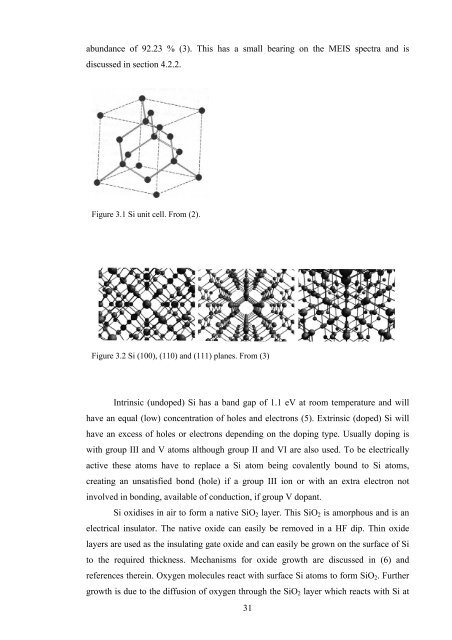Damage formation and annealing studies of low energy ion implants ...
Damage formation and annealing studies of low energy ion implants ...
Damage formation and annealing studies of low energy ion implants ...
You also want an ePaper? Increase the reach of your titles
YUMPU automatically turns print PDFs into web optimized ePapers that Google loves.
abundance <strong>of</strong> 92.23 % (3). This has a small bearing on the MEIS spectra <strong>and</strong> is<br />
discussed in sect<strong>ion</strong> 4.2.2.<br />
Figure 3.1 Si unit cell. From (2).<br />
Figure 3.2 Si (100), (110) <strong>and</strong> (111) planes. From (3)<br />
Intrinsic (undoped) Si has a b<strong>and</strong> gap <strong>of</strong> 1.1 eV at room temperature <strong>and</strong> will<br />
have an equal (<strong>low</strong>) concentrat<strong>ion</strong> <strong>of</strong> holes <strong>and</strong> electrons (5). Extrinsic (doped) Si will<br />
have an excess <strong>of</strong> holes or electrons depending on the doping type. Usually doping is<br />
with group III <strong>and</strong> V atoms although group II <strong>and</strong> VI are also used. To be electrically<br />
active these atoms have to replace a Si atom being covalently bound to Si atoms,<br />
creating an unsatisfied bond (hole) if a group III <strong>ion</strong> or with an extra electron not<br />
involved in bonding, available <strong>of</strong> conduct<strong>ion</strong>, if group V dopant.<br />
Si oxidises in air to form a native SiO2 layer. This SiO2 is amorphous <strong>and</strong> is an<br />
electrical insulator. The native oxide can easily be removed in a HF dip. Thin oxide<br />
layers are used as the insulating gate oxide <strong>and</strong> can easily be grown on the surface <strong>of</strong> Si<br />
to the required thickness. Mechanisms for oxide growth are discussed in (6) <strong>and</strong><br />
references therein. Oxygen molecules react with surface Si atoms to form SiO2. Further<br />
growth is due to the diffus<strong>ion</strong> <strong>of</strong> oxygen through the SiO2 layer which reacts with Si at<br />
31
















